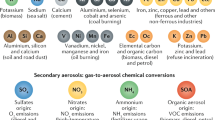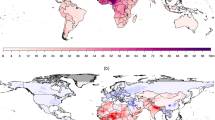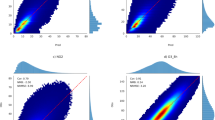Abstract
Studies of the effects of ambient air pollution on human health are complicated by the fact that individuals are exposed to a complex mixture of toxic and non-toxic substances that vary in their make-up in space and in time. It is impossible using standard epidemiological designs to uniquely identify any individual component of air pollution as a causal agent of a health effect because of simultaneous exposure to all or a subset of ambient pollutants. Nevertheless, associations observed for a particular pollutant can be interpreted as a marker of toxicity of the mixture, and regulatory action on judiciously selected pollutants can benefit health, as such actions can modify the complex mixture. This paper argues that we may be able to further our understanding of the effects of air pollution on human health by investigating whether particular mixtures are more toxic through (1) conducting and reporting results for all measured components; (2) possibly characterizing the complex mixture by developing synoptic categorizations of daily air pollution, through cluster or latent profile analysis; (3) a careful analysis of differences in the mixtures between locations; and (4) toxicological studies and controlled studies on humans that make use of factorial designs for various components of the air pollution mixture.
This is a preview of subscription content, access via your institution
Access options
Subscribe to this journal
Receive 6 print issues and online access
$259.00 per year
only $43.17 per issue
Buy this article
- Purchase on Springer Link
- Instant access to full article PDF
Prices may be subject to local taxes which are calculated during checkout

Similar content being viewed by others
References
Analitis A., Katsouyanni K., and Dimakopoulou K., et al. Short-term effects of ambient particles on cardiovascular and respiratory mortality. Epidemiology 2006: 17: 230–233.
Banfield J.D., and Raftery A.E. Model-based Gaussian and non-Gaussian clustering. Biometrics 1993: 49: 803–821.
Breslow N.E., and Day N.E. Statistical methods in cancer research. Volume I — The analysis of case–control studies. International Agency for Cancer, Lyon, France, 1980.
Brook R.D., Brook J.R., Urch B., Vincent R., Rajagopalan S., and Silverman F. Inhalation of fine particulate air pollution and ozone causes acute arterial vasoconstriction in healthy adults. Circulation 2002: 105: 1534–1536.
Burnett R.T., Brook J., and Dann T., et al. Association between particulate- and gas-phase components of urban air pollution and daily mortality in eight Canadian cities. Inhal Toxicol 2000: 12 (Suppl 4): 15–39.
Burnett R.T., Stieb D., and Brook J.R., et al. Associations between short-term changes in nitrogen dioxide and mortality in Canadian cities. Arch Environ Health 2004: 59: 228–236.
Clancy L., Goodman P., Sinclair H., and Dockery D.W. Effect of air-pollution control on death rates in Dublin, Ireland: an intervention study. Lancet 2002: 19: 1210–1214.
Dominici F., McDermott A., Daniels M., Zeger S.L., and Samet J.M. Revised analyses of the National Morbidity, Mortality, and Air Pollution Study: mortality among residents of 90 cities. J Toxicol Environ Health A 2005: 68: 1071–1092.
Goldberg M.S., Burnett R.T., Yale J.F., Valois M.F., and Brook J.R. Associations between ambient air pollution and daily mortality among persons with diabetes and cardiovascular disease. Environ Res 2006: 100: 255–267.
Kalkstein L.S., Tan G., and Skindlov J.A. An evaluation of three clustering procedures for use in synoptic climatological classification. Journal of Climate and Applied Meteorology 1987: 26: 717–730.
Meggs W.J. Neurogenic inflammation and sensitivity to environmental chemicals. Environ Health Perspect 1993: 101: 234–238.
Meggs W.J. Neurogenic switching: a hypothesis for a mechanism for shifting the site of inflammation in allergy and chemical sensitivity. Environ Health Perspect 1995: 103: 54–56.
National Research Council Committee on Health Risks of Exposure to Radon (BEIR VI). Health Risks of Exposure to Radon. BEIR VI. National Academy Press, Washington, DC, 1999.
Roberts S., and Martin M.A. Investigating the mixture of air pollutants associated with adverse health outcomes. Atmos Environ 2006: 40: 984–991.
Roberts S. A new model for investigating the mortality effects of multiple air pollutants in air pollution mortality time-series studies. J Toxicol Environ Health A 2006: 69: 417–435.
Sheridan S.C. The redevelopment of a weather-type classification scheme for North America. Int J Climatol 2002: 22: 51–68.
Stieb D.M., Doiron M.S., Blagden P., and Burnett R.T. Estimating the public health burden attributable to air pollution: an illustration using the development of an alternative air quality index. J Toxicol Environ Health A 2005: 68: 1275–1288.
Author information
Authors and Affiliations
Corresponding author
Rights and permissions
About this article
Cite this article
Goldberg, M. On the interpretation of epidemiological studies of ambient air pollution. J Expo Sci Environ Epidemiol 17 (Suppl 2), S66–S70 (2007). https://doi.org/10.1038/sj.jes.7500629
Received:
Accepted:
Published:
Issue Date:
DOI: https://doi.org/10.1038/sj.jes.7500629
Keywords
This article is cited by
-
Evidential requirements for the regulatory hazard and risk assessment of respiratory sensitisers: methyl methacrylate as an example
Archives of Toxicology (2023)
-
Panel discussion review: session two — interpretation of observed associations between multiple ambient air pollutants and health effects in epidemiologic analyses
Journal of Exposure Science & Environmental Epidemiology (2007)



